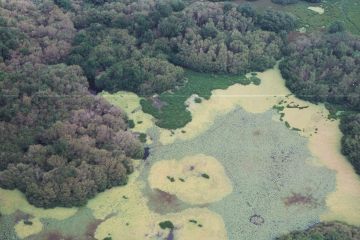http://www.jstor.org/stable/2560044
In the Cienaga Grande de Santa Marta, a brackish lagoon system on the Caribbean coast of Colombia, about 60% of the mangrove forests died from hypersalinization. The die-back was first encountered in 1964 and mass mortality started in the late 1960s. Although efforts are being made to reestablish the
destroyed areas, regeneration is slow, which may be partly due to Junonia evarete caterpillars defoliating Avicennia germinans seedlings. The interaction between insects and seedlings was studied. Both J. evarete butterflies and caterpillars were abundant during the main rainy season, the time of highest fruit production in A. germinans. During the dry season the herbivore disappeared. The caterpillars fed exclusively on A. germinans propagules, seedlings, and pneumatophores. They preferred young seedlings to older plants and did not feed on trees. At some sites, 100% of the A. germinans seedlings died due to the caterpillar attack. Seedlings at open, disturbed sites were attacked more than seedlings protected by small roofs and trenches or those under a closed canopy. Only seedlings protected by insect nets or seedlings germinating at the beginning of the dry season had good chances
of survival. The results suggest that in the highly disturbed areas of the Cienaga Grande regeneration of A. germinans is strongly inhibited by the feeding behaviour of J. evarete caterpillars



